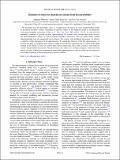Densities of states for disordered systems from free probability
Author(s)
Chen, Jiahao; Van Voorhis, Troy; Welborn, Matthew Gregory
DownloadWelborn-2013-Densities of states.pdf (293.3Kb)
PUBLISHER_POLICY
Publisher Policy
Article is made available in accordance with the publisher's policy and may be subject to US copyright law. Please refer to the publisher's site for terms of use.
Terms of use
Metadata
Show full item recordAbstract
We investigate how free probability allows us to approximate the density of states in tight-binding models of disordered electronic systems. Extending our previous studies of the Anderson model in one dimension with nearest-neighbor interactions [Chen et al., Phys. Rev. Lett. 109, 036403 (2012)], we find that free probability continues to provide accurate approximations for systems with constant interactions on two- and three-dimensional lattices or with next-nearest-neighbor interactions, with the results being visually indistinguishable from the numerically exact solution. For systems with disordered interactions, we observe a small but visible degradation of the approximation. To explain this behavior of the free approximation, we develop and apply an asymptotic error analysis scheme to show that the approximation is accurate to the eighth moment in the density of states for systems with constant interactions, but is only accurate to sixth order for systems with disordered interactions. The error analysis also allows us to calculate asymptotic corrections to the density of states, allowing for systematically improvable approximations as well as insight into the sources of error without requiring a direct comparison to an exact solution.
Date issued
2013-11Department
Massachusetts Institute of Technology. Computer Science and Artificial Intelligence Laboratory; Massachusetts Institute of Technology. Department of ChemistryJournal
Physical Review B
Publisher
American Physical Society
Citation
Welborn, Matthew, Jiahao Chen, and Troy Van Voorhis. “Densities of States for Disordered Systems from Free Probability.” Phys. Rev. B 88, no. 20 (November 2013). © 2013 American Physical Society
Version: Final published version
ISSN
1098-0121
1550-235X